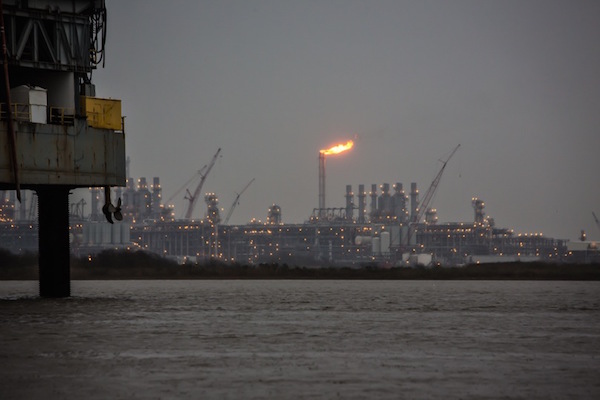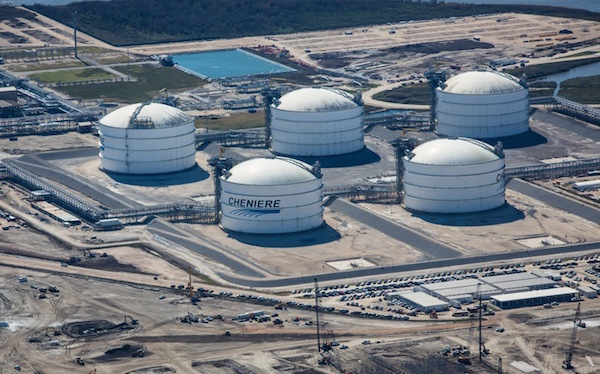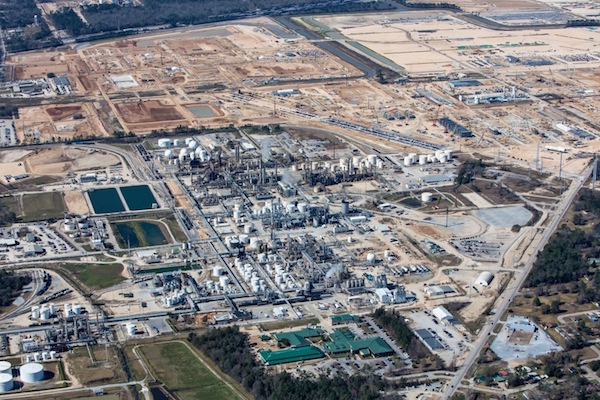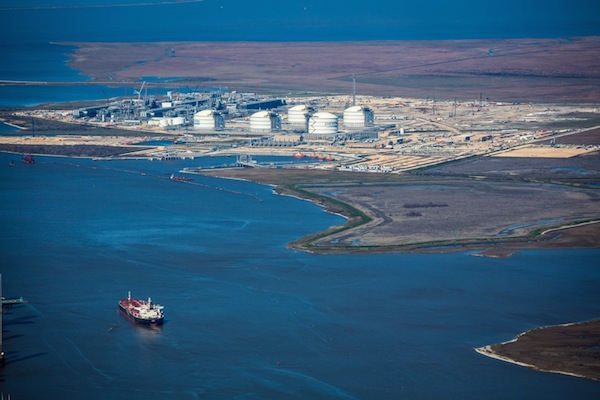Lambert: Interesting the political connections the exporters have.
By Julie Dermansky, a multimedia reporter and artist based in New Orleans. She is an affiliate scholar at Rutgers University’s Center for the Study of Genocide and Human Rights. Originally published at DeSmogBlog.
The Sabine Pass LNG terminal owned by Cheniere Energy in southwest Louisiana offers a glimpse of the challenges facing the growing natural gas industry in the United States.
The first cargo of liquefied natural gas (LNG) was scheduled for export from Cheniere Energy’s new export terminal in Cameron Parish, in January, but the company reportedly delayed its plans by up to two months due to faulty wiring.
Following the announcement of the export delay, Cheniere Energy sought $2.6 billion to refinance its adjacent LNG import terminal in Cameron Parish which was impacted by extreme fluctuations in the price of oil and gas. The company built the import facility before the U.S. fracking boom took hold, and was therefore saddled with unnecessary import infrastructure in the new age of abundance of domestic gas availability and the prospect of U.S. exports.
Cheniere’s $20 billion, multiphase terminal is one of four LNG terminals in the lower 48 states that got the green light from the Federal Energy Regulatory Commission. And the existing Kenai LNG plant in Alaska, an export terminal operated by ConocoPhillips, was recently permitted to restart operations after closing down in 2013, when operations ceased due to a shortage of gas.
“The Chenier Energy project, as well as the over 40 proposed or approved LNG export facilities around the United States, are a serious threat to our climate,” Gulf Restoration Network organizer Johanna deGraffenreid told DeSmog. She criticized the massive export infrastructure investment craze for “promoting the use of fossil fuels on an international scale.”
 A flare at Cheniere Energy Sabine Pass LNG facility. ©2016 Julie Dermansky
A flare at Cheniere Energy Sabine Pass LNG facility. ©2016 Julie Dermansky
But rather than acknowledging the climate risk posed by further expansion of LNG export infrastructure, the U.S. Congress and the Obama administration are moving in the opposite direction.
The natural gas export industry may grow even more rapidly if the first new bipartisan energy legislation drafted since 2007 passes. The Energy Policy Modernization Act of 2015, known as S. 2012, would expedite permitting for LNG export terminals.
The bill’s passage was considered imminent until it derailed with the introduction of an amendment that would provide emergency aid towards solving the lead-contaminated water crisis in Flint, Michigan. Now the passage of the bill hinges on whether the Senate will come to terms on aid to Flint.
Lobbying for the bill has been heavy. As DeSmog’s Steve Horn reported: “The list of lobbyists for S.2012 is a who’s who of major fossil fuel corporations and their trade associations: BP, ExxonMobil, America’s Natural Gas Alliance, American Petroleum Institute, Peabody Energy, Arch Coal, Southern Company, Duke Energy and many other prominent LNG export companies.”
 Cheniere Energy Inc. Sabine Pass LNG facility. ©2016 Julie Dermansky – Flight made possible by SouthWings
Cheniere Energy Inc. Sabine Pass LNG facility. ©2016 Julie Dermansky – Flight made possible by SouthWings
Horn also described the revolving door between the federal government and Cheniere Energy:
“Cheniere Energy, the first company in the fracking era to receive an export permit from the Obama Administration back in 2012, also has a politically connected Board of Directors. Among its members is Obama’s former climate czar, Heather Zichal.”
Horn continued: “Ankit Desai, a campaign finance bundler for Hillary Clinton’s 2016 run for president and former top-level aide to Vice President and then-U.S. Senator Joe Biden, is also on Cheniere’s lobbying payroll. Desai also formerly served as a top-level staffer for current U.S. Secretary of State and then-U.S. Senator John Kerry (D-MA).“
Also tied to lobbyists with political connections is Energy Transfer Partners (ETP). It bought The Williams Companies, owner of the Gulf Trace pipeline, which is set to feed into Cheniere Energy’s Sabine Pass LNG export terminal.
As Horn reported: “ETP — whose assets include both hotly contested proposed Dakota Access LLC pipeline and the Trans-Pecos Pipeline — is run by CEO Kelcy Warren, who served as an advisory committee member and donor to former Republican Party presidential candidate Rick Perry. Perry sits on ETP’s Board of Directors.“
According to lobbying disclosure forms, Adam Ingols, a lobbyist for Daryl Owen Associates, is the former chief of staff for the U.S. Department of Energy for President George W. Bush, and special assistant for the Bush White House Office of Legislative Affairs. He now lobbies for ETP at the federal level.
Bechtel Oil, Gas & Chemicals, Inc., the lead contractor for Cheniere’s LNG plant, also knows how to grease the wheels of the federal government. Bechtel Inc’s political action committee (PAC) has contributed $105,000 to federal candidates so far in the current election cycle, and poured $639,500 into the 2012 election cycle, according to the Center for Responsive Politics. Among the recipients of Bechtel’s PAC contributions in the 2014 cycle were Louisiana Senator Mary Landrieu ($5,000) and Rep. Charles Boustany ($5,000).
Natural Gas A Bridge To Nowhere Except Climate Disruption
Though natural gas is still touted by many as a clean, safe energy source, there is mounting proof to the contrary.
The in-depth report “Natural Gas Exports: Washington’s Revolving Door Fuels Climate Threat,” by DeSmog’s Steve Horn and Republic Report’s Lee Fang, shows how LNG interests have manipulated public opinion:
“Far from being a ’bridge fuel‘ towards a sustainable energy future, multiple reports reveal that methane leakage throughout the shale gas production lifecycle has produced dangerous levels of emissions, surpassing even coal in its climate disruption-causing potential. Despite this fact, and evidence that shale gas drilling has contaminated groundwater with cancer-causing agents, the federal government is on track to propel the gas industry to new heights by approving multiple liquefied natural gas (LNG) export terminals.”
Yet ongoing lobbying and advertising campaigns have kept alive the message that natural gas is a form of “clean” energy. The massive gas leak at Porter Ranch in Los Angeles is one of the latest examples of the risks the natural gas industry poses to communities.
And the U.S. Environmental Protection Agency draft report on the impact of hydraulic fracturing on water resources, including groundwater, made clear the fracking industry has contaminated water sources.
Yet the Obama Administration has played a major role in the fracking industry’s development at home and abroad. During Hillary Clinton’s tenure as Secretary of State, she promoted fracking throughout the world via the State Department’s Global Shale Gas Initiative.
In President Obama’s State of the Union speech after his 2012 re-election, he referred to natural gas as a bridge fuel, despite data showing that fracked gas can emit more harmful greenhouse gases than burning coal.
As a presidential candidate, Clinton still embraces natural gas. Her campaign released a fact sheet on ‘responsible natural gas production’ that states she is “committed to making America the world’s clean energy superpower and meeting the climate change challenge.” The fact sheet states:
“Domestically produced natural gas can play an important role in the transition to a clean energy economy, creating good paying jobs and careers, lowering energy costs for American families and businesses, and reducing air pollution that disproportionately impacts low income communities and communities of color. By putting in place new safeguards and raising labor standards, Clinton will ensure safe and responsible natural gas production as we move towards a clean energy future.”
Sharon Wilson, an anti-fracking activist and Gulf Coast representative for Earthworks, told DeSmog: “I’ve been hearing about ‘safe and responsible natural gas production‘ for about a decade now, but I’ve been to shale plays (geological formations where oil and gas are trapped in rock) all across the country, and I haven’t seen safe or responsible anywhere. It’s polluting land, air, and water, making neighbors sick, causing earthquakes, and devaluing private property.”
Wilson thinks Clinton’s natural gas fact sheet reads like oil and gas lobbyists wrote it.
Clinton’s rival for the Democratic presidential nomination, Bernie Sanders, is the only candidate who came out against the fracking industry. His plan to combat climate change includes banning fossil fuel lobbyists from working in the White House.
None of the Republican presidential candidates have embraced any new regulatory measures to govern the oil and gas industry or released a plan to deal with climate change.
 Lake Charles Sasol Chemical Complex. ©2016 Julie Dermansky – Flight made possible by SouthWings
Lake Charles Sasol Chemical Complex. ©2016 Julie Dermansky – Flight made possible by SouthWings
Despite the government’s natural gas industry-friendly plans, plummeting natural gas prices are showing signs of slowing the industry’s growth.
Sasol, a South African energy and chemicals company, has put the brakes on a multi-billion dollar gas-to-liquids plant it plans to build around Mossville, Louisiana, about 60 miles from the Sabine Pass.

Gulf Restoration Network organizer Johanna deGraffenreid on flight provided by Southwings to survey new oil and gas developments. ©2016 Julie Dermansky
Gulf Restoration Network’s deGraffenreid pointed out: “Not only are these fracked-gas projects unnecessary for public energy need or demand, they dramatically undermine the free market potential for renewable energy.”
By developing export terminals and permitting more pipelines to enable fracked gas exports, the U.S is poised to play a larger role in the global gas market, despite the federal government’s pledge to combat climate change.

Cheniere Energy Inc. Sabine Pass LNG facilities in Cameron, Louisiana. ©2016 Julie Dermansky – Flight made possible by SouthWings
Blog image: Cheniere Energy Inc. Sabine Pass LNG facility. ©2016 Julie Dermansky – Flight made possible by SouthWings


I get the impression that the push for LNG exports from the US is more of a sign of desperation by the fossil fuel industry than anything else. The crash in oil prices (which also impacts on gas and LNG wholesale prices) has caused panic and they are desperately seeking some source of long term growth. The problem is that all the oil companies are piling into gas, which is almost certainly going to cause a similar glut in the near future.
What is less commented upon is that the huge recent growth in renewables hits gas most directly. When the wind is blowing and the sun is shining, it is gas fired electricity plants which turn down, not coal or nuclear. An example would be (I choose this simply because there is a nice graph available) in the windy month of December 2012 in Ireland. In fact, the Irish gas supply company lost a lot of projected sales that winter because 2012 was a particularly windy year. As more and more wind turbines and solar panels are rolled out, it is gas demand which suffers.
You also have to question anyone making a major capital heavy investment in LNG plants when longer term supply in the US is very uncertain. Most projections are that fracked gas supply will drop off very rapidly within about 2 decades, maybe even much less. If that happens, gas will simply be too expensive to turn into LNG.
So a combination of a potential supply glut with demand projections that seem way too optimistic makes gas look like…. well, oil right now. I’m sure investors are noticing whats happening. So even in financial terms, it really makes very little sense for the US to invest so heavily in LNG.
I think my link above doesn’t work – its here:
http://www.eirgridgroup.com/site-files/library/EirGrid/All_Island_Wind_and_Fuel_Mix_Report_December_2012.pdf
For a live demonstration of the impact of a windy day in a country with 2GW of installed wind capacity, check here (its very windy here this morning):
http://www.eirgridgroup.com/how-the-grid-works/system-information/
Let’s hope you’re right. I’d also offer hope that debt markets are quite skittish about funding any energy projects right now. The defaults should start piling up over the next few months.
At present usage, the US has around a century of natural gas production. This doesn’t account for future discoveries. Natural Gas will also become more popular for Hydrogen extraction.
The US will only be able to maintain natural gas production on these levels for a century if you make truly heroic assumptions about shale productivity. Most independent commentators think its peaking already – the really productive plays are running down. A fracked gas well only lasts about 2 years, in comparison to a conventional one. Arthur Berman has been consistently right the past decade or so about US oil productivity – he is worth reading on the topic.
http://oilprice.com/Interviews/Shale-the-Last-Oil-and-Gas-Train-Interview-with-Arthur-Berman.html
It’s possible that using up nat gas, depleting gas fields, is part of the plan. We worry about methane bubbling up from the ocean and contributing to GW at a dangerous level without even the benefit of burning it for an energy source; we also know that nat gas is coming up through the thawed tundra all over the place and now we have the apocalypse known as Porter Ranch spewing nat gas everywhere along with concentrated residues of radon and other radioactives. So point being – the thinking could be to get as much of it up and out as we can use, leaving oil in the ground where it will stay put – until we can establish clean energy. maybe.
Where did you get those numbers?
The natural gas export facilities that have been permitted in the last few years were in planning when North American natty gas was 2-3x cheaper than in east Asia or Europe. They are not immediate expressions of desperation, although the untenable numbers in the planning pipeline may reflect – long term – excess capital chasing too few opportunities in a society with a dwindling consumer class.
The obvious problems are 1) natural gas is no longer expensive in east Asia, the demand there is slacker than it was, and there are other large regional producers mobilizing to supply the demand that remains (Russia, offshore West Australia). 2) The administration has given permits to even more export terminals than could make profit in good times. Many of them on the west coast, not the Gulf coast.
It’s deja vu all over again. Ten years ago Cambridge Energy Research Associates was predicting that natural gas would drop to $5/MMBtu by 2010 because the US would import cheaper natural gas from around the world. Many people thought they were nuts because natural gas was at $9/MMBtu. They were right about the $5 price but wrong about why it would get there. An import LNG facility was built but then fracking went full force and the price fell to $5 and below.
David’s comments below seem correct. Additionally, the House of Saud and Qatar are destroying Iraq and Syria so they can extend their pipeline to be able to cheaply get their huge supplies of natural gas to Europe. LNG exports from the US will probably end up like LNG imports did a decade ago.
Other than winter heating and some industrial processes, the bulk of natural gas is used in combustion turbines to produce electricity. A major shift is occurring as higher RPS standards come into play in the next 15 years. As utilities scramble to go from 26% RPS to 50% RPS in 2030 (in CA), not only is the fracking dropping the price but there is less demand as a result. Calpine just shut down a 500MW plant in northern CA because they didn’t have any long term contracts and have been running the plant to meet the market. There is less market demand because utilities are required to buy renewables.
As the price of solar and wind continue to drop and storage drops to the DOE’s $150/kWh, capacity and demand response will be met from those resources (due to the duck curve). More gas facilities will follow Calpine’s and gas will only be used for baseload combustion turbines. An executive from San Diego Gas and Electric recently stated that combustion turbines for electricity peaking running on natural gas will soon be obsolete and storage will replace them. search for: “Why energy storage is key to a future with ‘no more gas turbines'”
So much NOT:
We’ll need billions in infrastructure to import LNG – NOT.
LNG is better for the planet – NOT.
Refinancing a useless import facility, that’s a sorta renewable energy deal, right?
What I like about all this energy infrastructure, at least on the Gulf Coast, is that it’s all roughly at present sea level. One of the secondary effects of hurricane Katrina, we were there and suffered this, was the exposure to toxic whatevers washed over our neighbourhood from the Port Bienville gulf side industrial park. Pearlington is basically inshore of Port Bienville. Decades worth of industrial chemicals dumped in the branch canal of the shipping channels that served Port Bienville was washed inland by the storm surge associated with Katrina. Some of that silt, when dried and blown about by the winds, would form a weak acid when activated by sweat. We would have to wash it off, it itched and irritated that much. (This is weeks and months after the hurricane.)
So, if sea level rise comes in at faster than the ‘official version’ predicts, all those sea side chemical plants will have to be protected by levees, or moved. Both are expensive propositions. As a ‘tail effect’ of the LNG “boom,” this looks to be a biggie. If nothing is done; I wouldn’t want to eat any of the seafood coming from those waters.
This reminds me very much of the Aral Sea. The clouds of toxic dust causing health problems is the obvious symptom. The years of development that lead to the problem is what made the system fragile in the first place. For the Aral Sea it was dessication from irrigation and canals, for the Gulf Coast, the loss of wetland buffers. As long as the water levels were stable, the chemicals were out of sight and out of mind. Now, not so much.
What scares me, I just might still be alive when this monster comes to bite us all in the a—, is the sheer number of pollution sites in the sea level rise flood zone worldwide.
I remember seeing a Jacques Cousteau show on the TV where the Calypso crew salvaged a cargo of tetra ethyl lead in drums that had been sent to the bottom of the Med during WW2. During this, the voice over said that the cargo had the potential to create a gigantic ‘Dead Zone’ off of the southern coast of Italy. That was just one ship. Imagine hundreds of thousands of toxic sites in the ‘New Littoral’ around the world.
We have a century of intense work to do to clean up all our mess. At least.
Thank you for posting Julie Dermansky’s well-researched and enlightening article. So despite their messaging, the Obama administration and its industry-owned FERC juiced GDP by disregarding public health and environmental considerations and promoting fracking, related transport/transmission, LNG export terminals, refining and processing facilities. More fallout from the Supremes’ Citizens United decision and the revolving door culture in DC. I believe a majority of them can hardly wait to pass the TransPacific Partnership Agreement and the TTIP Agreement to lock it all up.
For what it’s worth, I know who I’m voting for.
US LNG is uneconomic to the EU and Japan – primary markets – Russian marginal cost to the EU can’t be beat and Japanese market via Australia, Indonesia and potentially Vladivostok has lower transportation cost structure as well.
These projects are DOA unless they are massively subsidized
David, that seems right to this former oil company executive. Also, no gas is cheaper than the gas being flared in much of the world. http://geology.com/articles/oil-fields-from-space/
Well, given our current energy policy of massive subsidies to the oil and gas industry, it’s likely exactly that way. “Give us money so that we can pay someone else to buy our stuff”
I am wondering what role increasing sanctions and deteriorating relations with Russia will play with access to Sakhalin LNG (Russian Far East – with consortiums there)
I had heard that LNG was net beneficial to the environment to the extent that is replaced coal plants (primarily in China). Is that incorrect?
The province of British Columbia in Canada has also been trying to build a series of major LNG export facilities. The current Premier of BC based her entire election platform in 2013 on the programme.
In their eagerness to get any sort of LNG projects underway, the BC gov’t is actually giving Petronas the natural gas entirely free of royalties, for at least seven years! That doesn’t take into account other tax breaks and incentives.
“Give us money so that we can pay someone to buy our stuff,” is pretty much the sum of supply side economics in the era of loose money, i.e. rampant corruption, unlimited malvestment.
Of course, in BC the micro-hydro and wind projects are also massively subsidized giveaways to well-connected players–i.e. greenwashed malvestment and corruption. The BC gov’t actually forbade the publicly-owned electric utility from building any new generating capacity for over a decade, in order to protect the 3P’s from any competition.
The juggernaut of industrial civilization puts the pedal to the metal until our greed, ignorance and stupidity cause our ignominious termination: human extinction and that of most life (if not all life) on this planet. While most of us heedlessly go on with our daily imperatives and mindless distractions.